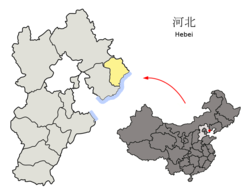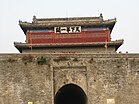Qinhuangdao
39°53′18″N119°31′13″E/ 39.8882°N 119.5202°E
Qinhuangdao
Tần hoàng đảo thị | |
|---|---|
Clockwise from the top: Aerial view of the city,Shanhai Pass,Longtan Falls,Yan Mountains,Old Dragon Head,Habitat Apartments | |
| Nickname(s): Back Garden of Beijing and Tianjin (Kinh tân hậu hoa viên) | |
 | |
 Location of Qinhuangdao City jurisdiction in Hebei | |
| Coordinates (People's Square):39°56′26″N119°35′42″E/ 39.9406°N 119.5951°E | |
| Country | People's Republic of China |
| Province | Hebei |
| Settled | 1737 |
| Established | March 3, 1983 |
| Municipal seat | Haigang District |
| Government | |
| • Party Secretary | Meng Xiangwei |
| • Mayor | Zhang Ruishu |
| Area | |
| •Prefecture-level city | 7,791.57 km2(3,008.34 sq mi) |
| • Urban | 2,122.9 km2(819.7 sq mi) |
| • Metro | 2,122.9 km2(819.7 sq mi) |
| Population (2020 census)[1] | |
| •Prefecture-level city | 3,136,879 |
| • Density | 400/km2(1,000/sq mi) |
| •Urban | 1,881,047 |
| • Urban density | 890/km2(2,300/sq mi) |
| •Metro | 1,881,047 |
| • Metro density | 890/km2(2,300/sq mi) |
| GDP[2] | |
| •Prefecture-level city | CN¥184 billion US$22.2 billion |
| • Per capita | CN¥ 48,230 US$7,143 |
| Time zone | UTC+8(China Standard) |
| Postal code | 066000 |
| Area code | (0)335 |
| ISO 3166 code | CN-HE-03 |
| Licence PlatePrefix | Ký C |
| Website | www.qhd.gov.cn |
| Qinhuangdao | |||||||||
|---|---|---|---|---|---|---|---|---|---|
 "Qinhuangdao", as written inSimplified Chinese(top) andTraditional Chinese(bottom) | |||||||||
| Simplified Chinese | Tần hoàng đảo | ||||||||
| Traditional Chinese | Tần hoàng đảo | ||||||||
| Literal meaning | Qin Shi HuangIsland | ||||||||
| |||||||||
Qinhuangdao(/ˈtʃɪnˈhwɑːŋˈdaʊ/;[4]Chinese:Tần hoàng đảo) is a port city on the coast of China in northernHebei.It is administratively aprefecture-level city,about 300 km (190 mi) east of Beijing, on theBohai Sea,the innermost gulf of theYellow Sea.Its population during the2020 national censuswas 3,136,879, with 1,881,047 people living in the built-up (or 'metro') area made up of four urban districts.
History[edit]
The city's name "Qinhuangdao"literally means"Qin Emperorisland ", and is allegedly originated from the legend that the JieshishanScenic AreainChangli Countywas the site ofFirst Emperor of Qin's famous ritual during his fourth and final survey tour to the east ( đông tuần ) in 210 BC. The "island" refers to the Nanshan area of thePort of Qinhuangdaoat the southern edge of the city'sHaigang District,which used to be a small offshore island until the lateQing dynasty,when dumping ofdredgedsiltjoined it to the mainlandafter theGuangxu Emperorapproved the port's construction in the late 19th century.
In the 19th century, Qinhuangdao included the separate towns ofQinhuangdaoandTanghe.[n 1]Both were stations along thePeking–Mukden Railway.The design and construction of the new harbour and port of Ching Wang Tao in the Gulf of Pechili was undertaken by the partnership of SirJohn Wolfe-Barryand Lt ColArthur John Barryat the turn of the 20th century.[5]
At the beginning of theChinese Civil War,Du Yuming'sNational Revolutionary Armyforces landed in the city at the beginning of theNationalist government's offensive against theChinese Communist PartyinSoviet-occupied Manchuria.They were unable to land further north because other ports were either occupied by the Soviet Union or already garrisoned by the military forces which would become thePeople's Liberation Army.[6]
Qinhuangdao Olympic Sports Center Stadiumwas used as one of the soccervenuesduring the2008 Summer Olympics.
Geography[edit]
Qinhuangdao sits on the northwest coast of theBohai Seaand bordersTangshanto the southwest,Chengdeto the northwest, andLiaoningto the northeast. Its administrative area ranges in latitude 39° 24' to 40° 37' N and in longitude from 118° 33' to 119° 51' E, and has a total area of 7,812.4 km2(3,016.4 sq mi).
Since the elevation ofTianjinto aprovincial-level municipality,Qinhuangdao is the chief port of Hebei. TheQinemperorQin Shi Huangis said to have sought immortality on an island inHaigang Districtbut did not find it.
Qinhuangdao has three main developed areas:
- Beidaihe:A summer seaside resort for senior government officials. Many political decisions affecting China are made here, making it the equivalent to resorts inMaineorCamp DavidinMaryland,United States.[United States-centric][7]
- Haigang:the harbor city. Qinhuangdao proper. Home ofYan Shan University,the leading university in NE Hebei province.
- Shanhaiguan:a popular tourist destination, featuring the eastern end of theGreat Wall.
Qinhuangdao's Olympic Sports Centre Stadium was used as an Olympic Competition Venue (Football Preliminary) during the2008 Summer Olympics.
Climate[edit]
Qinhuangdao has amonsoon-influencedhumid continental climate(KöppenDwa), with four distinct seasons. Winters are cold and dry due to theSiberian high,which often causes winds to blow in from the northwest, minimising the oceanic influence: the monthly daily average temperature in January is −5.6 °C (21.9 °F), colder than Beijing's −2.7 °C (27.1 °F).[8]Summers are hot and humid due to theEast Asian Monsoon,often allowing onshore flows; summer is also when the coast moderates the weather the most: the average high temperature in July here is 28.3 °C (83 °F), as compared to 31.8 °C (89 °F) in Beijing.[8]As measured by daily mean temperature, July and August are equally warm, averaging 24.7 °C (76.5 °F). The annual mean is 10.6 °C (51.1 °F), and 70% of the annual precipitation falls from June to August.
| Climate data for Qinhuangdao (1991–2020 normals, extremes 1971–2010) | |||||||||||||
|---|---|---|---|---|---|---|---|---|---|---|---|---|---|
| Month | Jan | Feb | Mar | Apr | May | Jun | Jul | Aug | Sep | Oct | Nov | Dec | Year |
| Record high °C (°F) | 12.7 (54.9) |
18.3 (64.9) |
25.6 (78.1) |
28.6 (83.5) |
37.1 (98.8) |
39.2 (102.6) |
39.2 (102.6) |
35.2 (95.4) |
34.2 (93.6) |
29.5 (85.1) |
21.6 (70.9) |
14.0 (57.2) |
39.2 (102.6) |
| Mean daily maximum °C (°F) | 0.1 (32.2) |
2.9 (37.2) |
9.2 (48.6) |
16.4 (61.5) |
22.4 (72.3) |
25.5 (77.9) |
28.3 (82.9) |
28.5 (83.3) |
25.3 (77.5) |
18.6 (65.5) |
9.7 (49.5) |
2.3 (36.1) |
15.8 (60.4) |
| Daily mean °C (°F) | −5.6 (21.9) |
−2.7 (27.1) |
3.7 (38.7) |
11.0 (51.8) |
17.3 (63.1) |
21.3 (70.3) |
24.7 (76.5) |
24.4 (75.9) |
19.8 (67.6) |
12.4 (54.3) |
3.9 (39.0) |
−3.1 (26.4) |
10.6 (51.0) |
| Mean daily minimum °C (°F) | −10.6 (12.9) |
−7.5 (18.5) |
−1.3 (29.7) |
6.1 (43.0) |
12.3 (54.1) |
17.5 (63.5) |
21.5 (70.7) |
20.6 (69.1) |
14.8 (58.6) |
6.9 (44.4) |
−1.0 (30.2) |
−7.7 (18.1) |
6.0 (42.7) |
| Record low °C (°F) | −26.0 (−14.8) |
−18.6 (−1.5) |
−13.1 (8.4) |
−5.0 (23.0) |
3.0 (37.4) |
9.9 (49.8) |
14.2 (57.6) |
11.4 (52.5) |
4.4 (39.9) |
−6.4 (20.5) |
−11.8 (10.8) |
−17.7 (0.1) |
−26.0 (−14.8) |
| Averageprecipitationmm (inches) | 2.6 (0.10) |
4.3 (0.17) |
7.9 (0.31) |
24.4 (0.96) |
47.6 (1.87) |
86.3 (3.40) |
171.2 (6.74) |
163.9 (6.45) |
47.0 (1.85) |
28.1 (1.11) |
15.0 (0.59) |
3.6 (0.14) |
601.9 (23.69) |
| Average precipitation days(≥ 0.1 mm) | 1.6 | 2.1 | 2.9 | 5.4 | 6.9 | 10.1 | 11.3 | 9.3 | 6.6 | 4.6 | 3.9 | 2.0 | 66.7 |
| Average snowy days | 2.8 | 2.4 | 1.6 | 0.3 | 0 | 0 | 0 | 0 | 0 | 0.1 | 1.6 | 2.6 | 11.4 |
| Averagerelative humidity(%) | 54 | 56 | 56 | 58 | 64 | 77 | 83 | 81 | 73 | 65 | 58 | 54 | 65 |
| Mean monthlysunshine hours | 189.3 | 187.4 | 235.4 | 243.5 | 262.0 | 218.2 | 188.4 | 209.9 | 221.6 | 204.7 | 174.7 | 178.5 | 2,513.6 |
| Percentpossible sunshine | 63 | 62 | 63 | 61 | 59 | 49 | 42 | 50 | 60 | 60 | 59 | 62 | 58 |
| Source 1:China Meteorological Administration[9][10] | |||||||||||||
| Source 2: Weather China[11] | |||||||||||||
Administrative divisions[edit]
| Map | |||||
|---|---|---|---|---|---|
| Name | Chinese | Pinyin | Population
(2020)[12] |
Area
(km2)[13] |
Density (/km2)[13] |
| Urban | |||||
| Haigang District | Hải cảng khu | Hǎigǎng Qū | 1,024,876 | 754.3 | 4,166 |
| Suburban | |||||
| Shanhaiguan District | Sơn hải quan khu | Shānhǎiguān Qū | 164,989 | 205.8 | 855 |
| Beidaihe District | Bắc đái hà khu | Běidàihé Qū | 130,104 | 158.1 | 822.9 |
| Funing District | Phủ ninh khu | Fǔníng Qū | 291,211 | 1,039 | 352.2 |
| Rural | |||||
| Changli County | Xương lê huyện | Chānglí Xiàn | 487,989 | 1,228 | 397.4 |
| Lulong County | Lư long huyện | Lúlóng Xiàn | 333,942 | 959.0 | 348.2 |
| Qinglong Manchu Autonomous County | Thanh long mãn tộc tự trị huyện | Qīnglóng Mǎnzú Zìzhìxiàn | 431,138 | 3,508 | 122.9 |
Development Zone[edit]
The Qinhuangdao Economic & Technology Development Zone was approved by theState Council of the People's Republic of Chinain 1984 to become one of China's first state-leveleconomic and technological development zones.Qinhuangdao is in the heart of the rapidly growing "Bohai-Rim Economic Circle", in easy reach of Beijing (280 km (170 mi)) and Tianjin (245 km (152 mi)).[14]It covers a sea area of 23.81 km2(9.19 sq mi) and has a coastline of 6 km (3.7 mi). The planned and controlled area of the development zone has reached 56.72 km2(21.90 sq mi). By the end of 2006, the number of approved projects reached 4,546, in which 647 projects were foreign-invested, with a total investment of US$4.73 billion.
QinhuangdaoExport Processing Zoneis the first export processing zone in Hebei Province. It passed joint appraisal held by theGeneral Administration of Customs,theState Development Planning Commission,and other six departments in 2003. Industries encouraged in the zone include electronics assembly and manufacturing, building/construction materials, computer software, trading and distribution.[15]
Economy[edit]

Qinhuangdao Portis a strategically important port and is the largest coal shipping port in the country, much of which is shipped topower plantselsewhere in China. With recent expansion, its capacity has reached 209 million metric tons. The harbor is adding a further six berths to add capacity and is increasingly being invested in by other port operators, such as South Africa'sPort of Richards Bay,who have announced plans to invest US$150 million to increase capacity by at least 28 percent.
China is the world's third largestcoal exporter,and Qinhuangdao is expected to handle much of the nation's coal exports. Rail links fromShanxi(China's largest coal producer) to Qinhuangdao Port are being upgraded, which should allow for Qinhuangdao to ultimately increase its throughput to 400 million tonnes of coal per annum from its current level of about 250 million tons by 2015. In 2018, the updated railway reached a record annual throughput of 451 million tons.[16]
Other Chinese and foreign service suppliers are moving to Qinhuangdao to support this.China Ocean Shipping(Group) Co, China's biggest shipping company, expects US$49 billion of spending on ports over the next five years as the industry tackles bottlenecks created by the nation's unprecedented economic boom.[17]
Qinhuangdao is on theJingshen Expresswaywhich links Beijing withShenyang,Liaoning. The city is served byQinhuangdao Beidaihe Airport.
Tourism[edit]
TheQinhuangdao Wildlife Parkwas opened in 1995 and is China's second largest wildlife park.[citation needed]
Red Ribbon[edit]
Qinhuangdao is home to theTanghe River Park,which features the Red Ribbon, a knee-high steel sculpture that runs the length of the park, providing seating, environmental interpretation, lighting, and the display of native plants. The project has won an honor award from theAmerican Society of Landscape Architectsand was selected by readers ofCondé Nast Travelermagazine as one of the seven new wonders of the architecture world.[18]
Education[edit]
- Yanshan University
- Northeastern University at Qinhuangdao
- Hebei Institute of International Business and Economics
- Hebei Normal University of Science and Technology
- Northeastern Petroleum University at Qinhuangdao
Sister cities[edit]
 Lugo,Galicia, Spain
Lugo,Galicia, Spain Pesaro,Marche, Italy
Pesaro,Marche, Italy Toledo,Ohio, United States, since 1985
Toledo,Ohio, United States, since 1985 Honolulu,Hawaii, United States, since May 5, 2010
Honolulu,Hawaii, United States, since May 5, 2010 Terrace,British Columbia, Canada, since November 30, 2015
Terrace,British Columbia, Canada, since November 30, 2015
Notes[edit]
- ^simplified Chinese:Thang hà;traditional Chinese:Thang hà;pinyin:Tānghé;Wade–Giles:Tang-ho;lit.'soup river'
References[edit]
- ^"China: Hébĕi (Prefectures, Cities, Districts and Counties) - Population Statistics, Charts and Map".
- ^Hà bắc tỉnh thống kế cục, quốc gia thống kế cục hà bắc điều tra tổng đội.《 hà bắc kinh tế niên giám -2018》.Trung quốc thống kế xuất bản xã.ISBN978-7-5356-7824-9.Archivedfrom the original on March 26, 2020.RetrievedJuly 11,2019.
- ^Ministry of Housing and Urban-Rural Development,ed. (2019).China Urban Construction Statistical Yearbook 2017.Beijing: China Statistics Press. p. 46.Archivedfrom the original on June 18, 2019.RetrievedJanuary 11,2020.
- ^"Qinhuangdao".Merriam-Webster.com Online Dictionary.Archived fromthe originalon September 1, 2014.RetrievedApril 25,2015.
- ^Frederick Arthur CrispVisitation of England and Wales,Volume 14, London (1906)
- ^Dikötter, Frank (2013).The Tragedy of Liberation: A History of the Chinese Revolution, 1945-1957(1 ed.). London: Bloomsbury Press. pp. 14–15.ISBN978-1-62040-347-1.
- ^"China Expat City Guide".Asia Briefing. 2009. Archived fromthe originalon January 18, 2009.RetrievedFebruary 8,2009.
- ^abTrung quốc địa diện quốc tế giao hoán trạm khí hầu tiêu chuẩn trị nguyệt trị sổ cư tập ( 1971-2000 niên )(in Simplified Chinese).China Meteorological Administration.Archived fromthe originalon September 21, 2013.RetrievedMay 28,2011.
- ^Trung quốc khí tượng sổ cư võng – WeatherBk Data(in Simplified Chinese).China Meteorological Administration.RetrievedOctober 8,2023.
- ^ "Experience Template"Trung quốc khí tượng sổ cư võng(in Simplified Chinese).China Meteorological Administration.RetrievedOctober 8,2023.
- ^Tần hoàng đảo - khí tượng sổ cư - trung quốc thiên khí võng(in Chinese). Weather China.RetrievedNovember 29,2022.
- ^"Quyền uy phát bố! Tần hoàng đảo nhân khẩu tối tân thống kế sổ cư lai liễu!".baijiahao.baidu.com.RetrievedAugust 11,2023.
- ^ab"China: Hébĕi (Prefectures, Cities, Districts and Counties) - Population Statistics, Charts and Map".www.citypopulation.de.RetrievedAugust 11,2023.
- ^"Qinhuangdao Economic & Technology Development Zone".RightSite.asia.Archived fromthe originalon August 1, 2012.RetrievedDecember 24,2012.
- ^"Qinhuangdao Export Processing Zone".RightSite.asia.Archived fromthe originalon August 1, 2012.RetrievedDecember 24,2012.
- ^""Trung quốc trọng tái đệ nhất lộ" đại tần thiết lộ 2023 niên hóa vận lượng siêu 4 ức đốn - trung tân võng ".www.chinanews.com.cn.RetrievedJanuary 29,2024.
- ^"China Briefing Business Guide"(PDF).China Briefing. 2009.RetrievedFebruary 8,2009.[permanent dead link]
- ^"Red Ribbon in Tanghe River Park".Contemporist.March 27, 2008. Archived fromthe originalon January 20, 2009.RetrievedDecember 19,2008.












